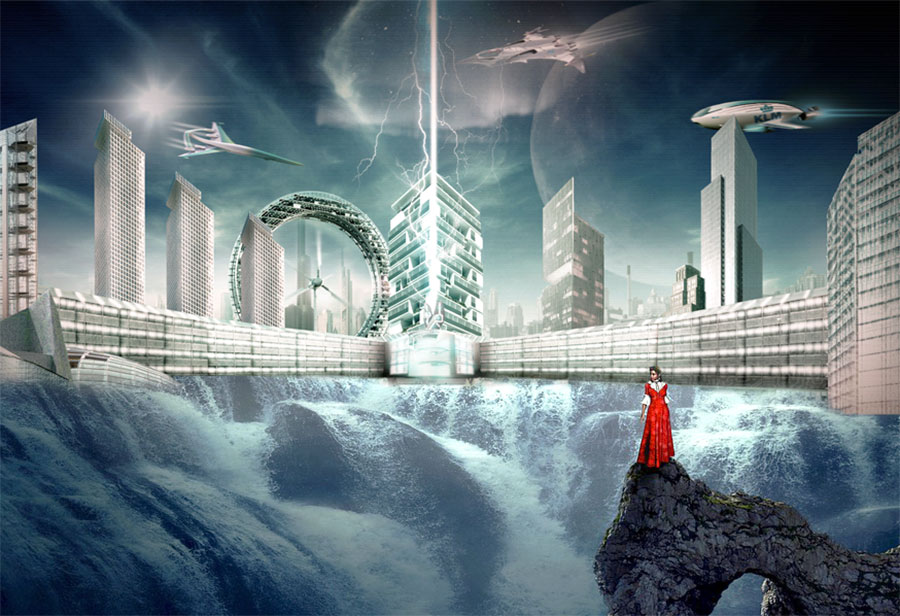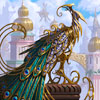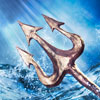Proofs Of Atlantis
 by Robert Charroux
by Robert Charroux
The submerged continent of Atlantis is best known from Plato’s story, which is corroborated by numbers of other Greek and Latin authors, such as Homer, Hesiod, Euripides, Strabo, Diodorus Siculus, Pliny, Tertullian, etc., who either repeat old traditions or add important details.
The most plausible story is that this continent was situated in the Atlantic; but it has also been sited in a number of other places. For a long time the very existence of Atlantis was doubted, but one may say that nowadays few would challenge its authenticity.
It is not proposed to give details about the origins of the story, which in any case are well known, but only to recall the main outlines, to introduce new features and to examine some of the most recent historical and archaeological discoveries.
The Story According to Critias
Two fragments of the Timaeus and Critias in Plato’s Dialogues introduced Atlantis to the world.
Critias was an Athenian statesman and philosopher, living about the year 450 B.C., a contemporary and a relative of Plato. His account was as follows:
‘Hear, O Socrates, a story that, though strange, is absolutely true according to Solon, the wisest of the Seven Sages….
‘Solon told that, when he visited the Egyptians, he was accorded great honour. He discussed ancient history with the most learned of their priests, and discovered that neither he himself nor any other Greek knew anything about the matter….
‘One of the priests, who was a very old man, said: Solon, you Greeks … how young you are; for you have no knowledge based on ancient tradition nor proved by the touchstone of Time….
‘Of our two cities–Sais and Athens–yours is the older by a thousand years … Since this land was civilised 8,000 years have passed, so say our sacred records….
‘I am therefore about to tell you briefly something of the laws and the splendid deeds of your ancestors of 9,000 years ago … We shall consider the full details on another occasion, when we have the leisure, by examining the actual texts….
‘Our books tell the story of how your city once destroyed a ruthless Power, which overwhelmed the whole of Europe and all Asia by attacking them from far out in the ocean.
‘At that time, it was possible to cross the sea. There was an island beyond the gateway which, so you tell me, you call the Pillars of Hercules (the Straits of Gibraltar). This island was larger than Libya and Asia put together, and travellers could in those days pass from there to other islands, and thence, on the far side of that sea, to a continent (America).
‘On the near side of the Straits of which we are speaking, it appears that there was only a single harbour, with a narrow mouth; but on the other there was the open sea and the land surrounding it, which one may rightly and in the true sense of the word term a continent.
‘The rulers of that Atlantic island had created a great and splendid empire, which controlled the whole of the island, as well as numbers of other islands and parts of the continent. In addition, on our side, this island held Libya as far as the Egyptian frontier, and Europe as far as Tyrrhenia (Southern Italy).
‘Having massed its forces, this Power determined to make one mighty effort to conquer your territory and ours, and all the other countries on the near side of the Straits.
‘It was then, O Solon, that your city dazzled all the world by its heroism and its vigour….
‘In the time which followed, however, there were fearful earthquakes and floods. In the space of a single terrible day and night the whole of your army was swallowed up in the earth, and the island of Atlantis itself vanished under the sea.
‘That is why, to this day, the sea in those parts is hazardous and impossible to explore, by reason of the tremendous depths of mud and slime deposited by the island as it sank (The Sargasso Sea).
‘You have heard briefly, O Socrates, the story told by the aged Critias (the grandfather of the narrator), which he had from Solon….’
Atlantis Swallowed Up
The Critias follows the Timaeus.
Critias speaks, telling Timaeus and Socrates of the high degree of civilisation attained in Atlantis.
“Atlantis was rich in metals, in fruits and animals unknown to the rest of the world. Its inhabitants were men of honour and acquired their wealth in harmony and virtue.
“Unfortunately they succumbed to the inexorable law of decadence; the human elements of luxury and greed gained ascendancy over the divine element.
“They made war to aggrandise themselves, and God punished them by destroying their land.”
It is clear from this description that the story which Plato ascribes to Critias is the absolute truth, and the author insists that it should be treated as such.
In The Republic Plato inveighs vehemently against Hesiod and Homer as ‘dangerous romancers’ distorting historical truth. The documents from which the priest at Sais had taken his information undoubtedly existed in Egypt.
The events narrated occurred nearly 12,000 years ago, and it is worth noting that the Flood is dated just 12,000 years ago by geologists who have studied the action of ice.
According to this account Atlantis was situated in the middle of the Atlantic Ocean, between America on the one side and Europe and North Africa on the other. Its capital was Poseidonis. It is calculated that its centre was somewhere near the Azores, which would explain the very uneven depths of the sea thereabouts.
The Atlanteans invaded Great Britain, Gaul, Spain, Italy and all the Mediterranean countries; no doubt also, though it is not mentioned in this account, the American coasts.
These are the very places in which the greatest number of Celtic megaliths are found–tumuli, pyramids, dolmens, menhirs–an important point.
Before the Flood, therefore, several great civilisations existed–foremost among them Atlantis, and second Greece. These civilisations were destroyed by the cataclysm, and it goes without saying that the continent of Atlantis did not sink without occasioning world-wide tidal disturbances that caused destruction and disaster in all nations. It seems curious, by the way, that the priest of Sais made no mention of havoc caused in Egypt during the ‘universal’ deluge, though it could hardly have escaped damage.
The story matches the account in Genesis, where God repented that He had made man and determined to destroy all living things by bringing ‘a flood of waters upon the earth to destroy all flesh wherein is the breath of life’.
One important point only has been omitted, that which speaks of a race of giants.
Proofs of the Existence of Atlantis
There are many indications to confirm the existence of Atlantis. Some of the main ones are as follows:
Numbers of small islands round the Azores, constituting navigational hazards, as mentioned in the Timaeus.
The fissure known as the Atlantic Ridge which runs from Iceland to the Antarctic like a great scar.
Between the Ridge and the continents are the submarine beds of the rivers Hudson, Loire, Seine, Rhine, etc.
In 1898 a cable-ship working in the Atlantic pulled up, from a depth of 10,000 feet, a piece of vitreous lava with the chemical composition of basalt; the fragment is now in a museum in Paris. But lava will undergo this chemical change only under normal atmospheric pressure, so the bed of the Atlantic, some 500 miles north of the Azores, must have been covered by a flow of lava while it was still above water.
Madame Maria Klionova, an expert in mineralogy and geology, doing a tour of duty on board the Russian laboratory ship Mikhael Lomonossov, discovered an uncharted mountain under the North Atlantic which she believes to be part of a continent existing 15,000 years ago.
Plato could not have guessed at the existence of the lava, nor of the Great Ridge, nor the exact date of the Flood (which was only determined in 1964), nor the Sargasso Sea, nor the American continent beyond Atlantis, nor the existence of the Gulf Stream when, in the Critias, he spoke of a spring of water that was simultaneously hot and cold.
He was also unaware that, according to Wegener’s theory, continental drift would account for the destruction of the great island lying across the line of the Atlantic Ridge.
Petrels, small brown migratory birds, cross the Atlantic from Europe to America every September and October. When they reach a point about 600 miles south-west of Cape Verde, they circle round persistently, then set off again towards Brazil. Their memory-chromosomes tell them that once upon a time there was a landing-place here—Atlantis.
The inlandsis of America and Europe, consisting of cumulations of ice resting upon a continental base, suggest that they must once have been part of a general inlandsis covering the whole of a terrain now lying beneath the ocean. This seems to show conclusively that during the Ice Age a continent existed half-way across the Atlantic.
There are similarities between the miocene flora of Europe and the present-day flora of eastern America.
Finally, there are the reproductive habits of eels, the females of which, being accustomed to inland waters, go to the Sargasso Sea in the spawning season, impelled by their memory-chromosomes.
Secret Archives
According to Anubis Schenouda, an Initiate, ‘secret Coptic archives refer to solid earth existing where the waters of the North Atlantic are now’. These archives also recall that on three occasions the poles changed their position in the plane of the ecliptic.
‘We Copts,’ writes Anubis Schenouda, ‘know that the poles and the plane of the ecliptic have coincided, as shown in the Denderah Zodiac, where the Lion is on the tail of the Serpent. We also know that three dynasties signify three orders of celestial Spirits–Giants, Titans and Cabiri.’
Constant Basir, referring to the Melpomene of Herodotus, mentions someone who, in 2350 B.C., visited both the mainland of Atlantis and a maritime Atlantis.
Basir speaks of an exodus of Atlanteans to Locmariaquer, but without giving the source of his information.
Aelian, in Varia Historia (Chapter XVIII, Book III), says that Theopompus gave an account of an interview between the King of Phrygia and Silenus, in the course of which the latter referred to an enormous continent, larger than Asia, Europe and Libya put together, which lay on the far side of the Atlantic.
This story is repeated in greater detail by Arbois de Jubainville in his book The First Inhabitants of Europe.
He writes that, according to Theopompus, who lived in the fourth century B.C., the story of Atlantis was part of the information given by Silenus to King Midas of Phrygia, whose prisoner he was. ‘Europe, Asia and Africa form an island surrounded by the Ocean as by a circle. There is only one single continent, and that lies elsewhere. It is of immense size; it breeds huge animals, and men who are twice as tall as we are.’
All traditions agree that the Alanteans were giants. ‘One day, it seems, these giants decided to come over to our part of the world and, ten million of them having crossed the ocean, they reached the country of the Hyperboreans.’ (Which is to say those regions that were ruled over by Celts in the fourth century B.C. A Greek author contemporary with Theopompus calls the Gauls who had conquered Rome Hyperboreans.)
‘The conquerors reconnoitered the country in which they had landed. They were told that the Hyperboreans were the most fortunate people in the world, but the invaders saw with scorn the wretched conditions in which these Hyperboreans lived, and disdained to go further.’
The teaching of the Druids, as reported by the Greek historian Timagenes, who lived in the first century B.C., agrees with that of Plato and Theopompus.
Another writer of about the same date refers to seven islands in the Atlantic near Europe (the Canaries), and adds that the inhabitants of these islands had preserved the memory of a very much larger island called Atlantis, which had for a long time ruled the other Atlantic islands.
‘So,’ says Arbois de Joubainville, ‘there are four texts that report traditions drawn from different sources, all of which agree in describing the conquest of a part of the Old World by strangers from an unknown country, which is called “Atlantis” in two of the texts.’
According to Druidic tradition, the people who invaded Gaul came from very distant islands from which they had been forced to flee by the encroachment of the sea.
‘At some times the earth seemed to rise up and at others to sink,’ wrote the historian Posidonius in the first century B.C.; and he continued: ‘One may admit that Plato’s account of Atlantis is no fiction. Indeed, there are more reasons to accept the story than to reject it.’
From Seneca to Paul Lecour
More receptive to the unusual, more open-minded than many a modern historian, Seneca, in his Medea, visualised the kind of ‘end of the world’ which the Atlanteans must have experienced. ‘A time will come in future centuries when the sea will burst its bonds; new worlds will open before us; and, of the lands we know, Thule will no longer be the most distant.’
According to Baldwin’s Ancient America, certain Central American documents state that the continent of America extended far into the Atlantic Ocean, but that that part of the country was destroyed by a series of appalling catastrophes, recurring at long intervals.
This is also what the Abbe Brasseur de Bourbourg found in the Troano manuscript, now kept in the Mayan section of the French National Library.
S. Bailly, French Astronomer Royal in 1779, working on some astronomical tables brought from the Indies by the Jesuits, sited Atlantis in Mongolia. Buffon, who was also interested in the question, thought it had been part of the mainland of America.
Thousands of people have written about Atlantis. Some, like A. Giraud, who founded ‘The Atlantis Society of Tomorrow’, located it in the Sahara, but it fell to Paul Le Cour, who first published the magazine Atlantis, to make the most telling point.
He agreed with Plato in siting the governmental centre of Atlantis in the Azores, and suggested that in the north it was joined to the Hyperborean continent by an isthmus.
The outlying parts of Africa, Europe and America were connected to Hyperborea, thus forming one enormous mass of land, united in the Arctic regions, where the New World met the Old World. This is the most generally accepted theory nowadays, and it seems very probable that submarine archaeology will in the end prove it to be right.
The Mystery of the Guanches
In the year 1406, Frenchmen, who were the first Europeans to land in the Canary archipelago, found a tall, fair-skinned people the Guanches who believed themselves to be the last survivors of the Flood.
The Spaniards, when they came later, were astonished to find the indigenous population, especially those in the Orotava Valley, fairer than the purest-blooded Castilians.
The Guanches were all massacred by the Europeans, and there are now no descendants whatever of this magnificent race, whose average height was over six feet.
Like the Celts, the Guanches, although gentle-mannered and hospitable, were fiercely independent, and preferred death to slavery.
Jean de Bethencourt, Chamberlain to King Charles VI of France, was ‘amazed at their courage and their incorruptibility. His companions, having rounded up a number of women who had taken refuge in a cave at Fuerteventura, saw one of them kill her baby so that it should not fall into the hands of the invaders.’
In ancient times the hospitality of the Guanches to friendly travellers was renowned; they even felt it their duty to offer their own wives to visitors. One should perhaps add that on the island of Gomera all the women were held in common by the clan. According to tradition, these people claimed descent from King Uranus, the first ruler of Atlantis, who was believed to have reigned some 20,000 years earlier.
‘Scratch an Egyptian, a Libyan, a Guanche or a Mayan, and you will find Atlantis,’ writes P. Couteaud in his book about the Atlanteans. He adds that the Egyptians are the Atlanteans of the east, which agrees with the tradition that they came from a country far westward.
The question is, were the Guanches refugees from Atlantis and so the most direct descendants of the inhabitants of Poseidonis? One is inclined to think so when comparing their rites and customs with those of hybrid Atlanteans–that is, Celts, Egyptians, Mexicans and Peruvians.
On the island of Fuerteventura there are megalithic monuments of the same type as those at Stonehenge and Carnac—cromlechs, menhirs, alignments.
On the island of Hierro there are cave-tombs where the Guanches laid their mummified dead beside altars that were either pyramidal or truncated cones, just like those in Mexico. A thousand mummies were found in a cave at Barranco de Herque, laid in niches, as in Peru. The mummies may be seen in the museum at Las Palmas, surrounded by all the things they would be likely to need in a future life.
Near Valverde, at a place called Los Letrero, is a slab of lava inscribed with some very curious hieroglyphics that have not yet been deciphered; the same mysterious script has been found in a ravine at Candia and on the island of Gomera.
Numidian inscriptions–Numidia was a country lying between ancient Carthage and Mauretania (Morocco )–seem to suggest that Africans also knew these other countries in olden days.
Barros, in his History of the Portuguese in the West Indies, refers to an equestrian statue said to have been discovered at Corvo, on the most northerly island in the Azores. The pedestal on which it stood was covered with inscriptions in unknown characters, believed to be Phoenician.
Did Jesus Visit the Guanches?
So much distortion has crept into the history of mankind, that it may not be altogether unprofitable to add to the file on Atlantis a few suggestions which, though they may appear far-fetched, might at some future date be found to rest on a more solid foundation than anyone would dare to suppose at present.
Maurice Guignard, author of the book How I Deciphered The Etruscan Language, translated into French the sacred formulae chanted by Guanche, Lydian and Etruscan priestesses conducting what he terms proto-Christian rites which, he says, means Druidic. He writes:
‘For thousands of years the Guanches kept alive these sacraments, but certain heretics, the offspring of Lydian soldiers and Cushite women, seceded from the old religion, keeping only the doctrine of the One God. The orthodox, to counter the heretics, founded the Essene community in memory of their northern ancestors. (Essenes = is-sonir = sons of ice).
‘Christ and his Mother were members of this sect. Christ was an ordained priest in the Atlantean isles and, as an Essene priest, he could not have instituted the neo-Christian sacraments attributed to him. On the contrary, he would have restored the ancient Essene-Druidic sacraments.’
Maurice Guignard, in another book entitled The Lydian ‘A’ Bible, affirms that the Guanches had innumerable [sic] extracts from the early Bible graved on their tombstones. This primitive Bible was later falsified in translation, he thinks. In any case, apart from enigmatic inscriptions at Los Letrero, Candia and Gomera, it does not appear that any extracts, biblical or otherwise, have been found on Guanche monuments.
Again according to M. Guignard, Guanche or Kvan-Skessiks, was the cryptic language of Greek, Mayan, Inca, Egyptian and Etruscan priests in celebrating their mysteries and initiatory ceremonies. He states, moreover, that he has factual proofs that Jesus spent that part of his life in the Canaries which is referred to in the Gospels as being ‘led up of the Spirit into the wilderness’.
F. Couteaud states that the Guanches worshipped the Virgin Mary, whom M. Guignard calls Thurma or Mikil, the Giant Virgin. The most celebrated of the sanctuaries dedicated to Mikil by the Norsemen were the Mont Saint Michel and Chartres.
According to the ancients, Paradise lay in the West, variously sited near the Isles of the Blessed, at Thule, in the Garden of the Hesperides, the Isle of St. Brendan and the Island of Seven Cities.
What strange fantasies are concealed within these myths, in which one feels that there must be a germ of historical truth, though somehow lost?
And how can one fail to see the Canaries as the ‘Island of Seven Cities’, although it would more correctly be styled the ‘Archipelago of the Seven Islands’–Tenerife, Fuerteventura, Gran Canaria (Las Palmas), Lanzarote, Palma, Gomero and Hierro?
Excerpt from The Mysterious Unknown
Posted in Atlantis, True History of Manwith comments disabled.





